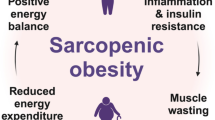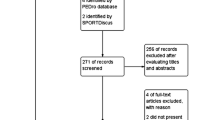Abstract
Objectives
Primary Sjögren’s syndrome leads to pain and fatigue that may cause impaired muscle function and muscle mass. This study aimed to determine the presence of pre-sarcopenia and to clarify associated factors with pre-sarcopenia in primary Sjögren’s syndrome patients.
Method
This cross-sectional study recruited 49 patients with primary Sjögren’s syndrome and 49 age- and gender-matched healthy controls. Sarcopenia was assessed according to European Working Group on Sarcopenia in Older People in 2018 (EGSWOP2) criteria by evaluating muscle mass, gait speed, and grip strength. Physical function was also assessed with five times sit-to-stand (FTSTS) test. Quality of life (QoL), psychological symptoms, and nutritional status were evaluated using Sarcopenia Quality of Life (SarQoL) questionnaire, Hospital Anxiety and Depression Scale (HADS), and Mini Nutritional Assessment Long Form (MNA-LF), respectively.
Results
Pre-sarcopenia was detected in 28.5% of patients with primary Sjögren’s syndrome and 6.1% of healthy controls (p = 0.006). Patients with pre-sarcopenia were older and had worse scores in terms of depression, QoL, pain scores, grip strength, and gait speed compared with those without pre-sarcopenia. The SarQoL scores and grip strength were significantly correlated with gait speed, pain, FTSTS test, and depression. Logistic regression analyses identified that the independent predictive factor for pre-sarcopenia was QoL (OR: 0.79, 95% CI: 0.65–0.95; p = 0.015).
Conclusions
Maintaining adequate muscle mass and muscle function in patients with primary Sjögren’s syndrome may contribute toward improving health-related QoL. Also, controlling depression and malnutrition risk may help to reduce the risk of development of sarcopenia.
Key Points • Pre-sarcopenia is detected in 28.4% of the patients with primary Sjögren’s syndrome which is higher than healthy controls. • Pre-sarcopenia is associated with health-related quality of life in primary Sjögren’s syndrome. • Psychological symptoms and low physical performance are more common in pre-sarcopenic patients. |
Similar content being viewed by others
References
Omdal R, Mellgren SI, Norheim KB (2019) Pain and fatigue in primary Sjögren’s syndrome. Rheumatology 60(7):3099–3106
Colak S, Tekgoz E, Hayme S, Sonaeren I, Cinar M, Yilmaz S (2020) The risk of presarcopenia is increased among female patients with primary Sjögren’s syndrome. J Clin Rheumatol. https://doi.org/10.1097/RHU.0000000000001669
Fuggle N, Shaw S, Dennison E, Cooper C (2017) Sarcopenia. Best Pract Res Clin Rheumatol 31(2):218–242. https://doi.org/10.1016/j.berh.2017.11.007
Hackett KL, Newton JL, Frith J, Elliott C, Lendrem D, Foggo H et al (2012) Impaired functional status in primary Sjögren’s syndrome. Arthritis Care Res 64(11):1760–1764. https://doi.org/10.1002/acr.21738
Vitali C, Del Papa N (2015) Pain in primary Sjögren’s syndrome. Best Pract Res Clin Rheumatol 29(1):63–70
Ng WF, Miller A, Bowman SJ, Price EJ, Kitas GD, Pease C et al (2017) Physical activity but not sedentary activity is reduced in primary Sjögren’s syndrome. Rheumatol Int 37(4):623–631. https://doi.org/10.1007/s00296-016-3637-6
Cruz-Jentoft AJ, Sayer AA (2019) Sarcopenia. Lancet 393(10191):2636–2646. https://doi.org/10.1016/S0140-6736(19)31138-9
Woo T, Yu S, Visvanathan R (2016) Systematic literature review on the relationship between biomarkers of sarcopenia and quality of life in older people. J Frailty Aging 5(2):88–99. https://doi.org/10.14283/jfa.2016.93
Salaffi F, Farah S, Di Carlo M (2020) Frailty syndrome in musculoskeletal disorders: an emerging concept in rheumatology. Acta Biomed 91(2):274. https://doi.org/10.23750/abm.v91i2.9094
Li TH, Chang YS, Liu CW, Su CF, Tsai HC, Tsao YP et al (2021) The prevalence and risk factors of sarcopenia in rheumatoid arthritis patients: a systematic review and meta-regression analysis. Semin Arthritis Rheum 51(1):236–245. https://doi.org/10.1016/j.semarthrit.2020.10.002
Michaud M, Balardy L, Moulis G, Gaudin C, Peyrot C, Vellas B et al (2013) Proinflammatory cytokines, aging, and age-related diseases. J Am Med Dir Assoc 14(12):877–882. https://doi.org/10.1016/j.jamda.2013.05.009
Cruz-Jentoft AJ, Romero-Yuste S, Chamizo Carmona E, Nolla JM (2021) Sarcopenia, immune-mediated rheumatic diseases, and nutritional interventions. Aging Clin Exp Res 33(11):2929–2939. https://doi.org/10.1007/s40520-021-01800-7
Cruz-Jentoft AJ, Bahat G, Bauer J, Boirie Y, Bruyère O, Cederholm T et al (2019) Sarcopenia: revised European consensus on definition and diagnosis. Age Ageing 48(1):16–31. https://doi.org/10.1093/ageing/afz046
Al Khayyat SG, Falsetti P, Conticini E, D’Alessandro R, Bellisai F, Gentileschi S et al (2021) Low muscle mass and body composition analysis in a group of postmenopausal women affected by primary Sjögren’s syndrome. Reumatologia 59(3):153. https://doi.org/10.5114/reum.2021.106909
Carubbi F, Alunno A, Conforti A, Riccucci I, Di Cola I, Bartoloni E et al (2020) Characterisation of articular manifestations in primary Sjögren’s syndrome: clinical and imaging features. Clin Exp Rheumatol 38(4 Suppl 126):166–173
Shiboski CH, Shiboski SC, Seror R, Criswell LA, Labetoulle M, Lietman TM et al (2017) 2016 American College of Rheumatology/European League Against Rheumatism classification criteria for primary Sjögren’s syndrome: a consensus and data-driven methodology involving three international patient cohorts. Ann Rheum Dis 76(1):9–16. https://doi.org/10.1136/annrheumdis-2016-210571
Von Elm E, Altman DG, Egger M, Pocock SJ, Gøtzsche PC, Vandenbroucke JP et al (2014) The Strengthening the Reporting of Observational Studies in Epidemiology (STROBE) Statement: guidelines for reporting observational studies. Int J Surg 12(12):1495–1499. https://doi.org/10.1016/j.ijsu.2014.07.013
Seror R, Ravaud P, Bowman SJ, Baron G, Tzioufas A, Theander E et al (2010) EULAR Sjögren’s syndrome disease activity index: development of a consensus systemic disease activity index for primary Sjögren’s syndrome. Ann Rheum Dis 69(6):1103–1109. https://doi.org/10.1136/ard.2009.110619
Seror R, Ravaud P, Mariette X, Bootsma H, Theander E, Hansen A et al (2011) EULAR Sjögren’s Syndrome Patient Reported Index (ESSPRI): development of a consensus patient index for primary Sjögren’s syndrome. Ann Rheum Dis 70(6):968–972. https://doi.org/10.1136/ard.2010.143743
Wang J-G, Zhang Y, Chen H-E, Li Y, Cheng X-G, Xu L et al (2013) Comparison of two bioelectrical impedance analysis devices with dual energy X-ray absorptiometry and magnetic resonance imaging in the estimation of body composition. J Strength Cond Res 27(1):236–243. https://doi.org/10.1519/JSC.0b013e31824f2040
Sarikaya D, Halil M, Kuyumcu ME, Kilic MK, Yesil Y, Kara O et al (2015) Mini nutritional assessment test long and short form are valid screening tools in Turkish older adults. Arch Gerontol Geriatr 61(1):56–60. https://doi.org/10.1016/j.archger.2015.04.006
Erdogan T, Eris S, Avci S, Oren MM, Kucukdagli P, Kilic C et al (2021) Sarcopenia quality-of-life questionnaire (SarQoL)®: translation, cross-cultural adaptation and validation in Turkish. Aging Clin Exp Res 33(11):2979–2988. https://doi.org/10.1007/s40520-020-01780-0
Beaudart C, Biver E, Reginster J-Y, Rizzoli R, Rolland Y, Bautmans I et al (2015) Development of a self-administrated quality of life questionnaire for sarcopenia in elderly subjects: the SarQoL. Age Ageing 44(6):960–966. https://doi.org/10.1093/ageing/afv133
Mukaka MM (2012) A guide to appropriate use of correlation coefficient in medical research. Malawi Med J 24(3):69–71
Petermann-Rocha F, Balntzi V, Gray SR, Lara J, Ho FK, Pell JP et al (2022) Global prevalence of sarcopenia and severe sarcopenia: a systematic review and meta-analysis. J Cachexia Sarcopenia Muscle 13(1):86–99. https://doi.org/10.1002/jcsm.12783
Fernandes LV, Paiva AEG, Silva ACB, de Castro IC, Santiago AF, de Oliveira EP et al (2021) Prevalence of sarcopenia according to EWGSOP1 and EWGSOP2 in older adults and their associations with unfavorable health outcomes: a systematic review. Aging Clin Exp Res:1-10. https://doi.org/10.1007/s40520-021-01951-7
Ramirez E, Salas R, Bouzas C, Pastor R, Tur JA (2022) Comparison between original and reviewed consensus of European Working Group on sarcopenia in older people: a probabilistic cross-sectional survey among community-dwelling older people. Gerontology 68(8):869–876. https://doi.org/10.1159/000519304
Bahat G, Erdoğan T, İlhan B (2022) SARC-F and other screening tests for sarcopenia. Curr Opin Clin Nutr Metab Care 25(1):37–42. https://doi.org/10.1097/MCO.0000000000000801
Witham MD, Heslop P, Dodds RM, Clegg AP, Hope SV, McDonald C et al (2022) Performance of the SarQoL quality of life tool in a UK population of older people with probable sarcopenia and implications for use in clinical trials: findings from the SarcNet registry. BMC Geriatr 22(1):1–10. https://doi.org/10.1186/s12877-022-03077-5
Lendrem D, Mitchell S, McMeekin P, Bowman S, Price E, Pease CT et al (2014) Health-related utility values of patients with primary Sjögren’s syndrome and its predictors. Ann Rheum Dis 73(7):1362–1368. https://doi.org/10.1136/annrheumdis-2012-202863
Miyamoto ST, Valim V, Fisher BA (2021) Health-related quality of life and costs in Sjögren’s syndrome. Rheumatology 60(6):2588–2601. https://doi.org/10.1093/rheumatology/key370
Burmester GR, Bijlsma JW, Cutolo M, McInnes IB (2017) Managing rheumatic and musculoskeletal diseases—past, present and future. Nat Rev Rheumatol 13(7):443–448. https://doi.org/10.1038/nrrheum.2017.95
Geerinck A, Bruyère O, Locquet M, Reginster J-Y, Beaudart C (2018) Evaluation of the responsiveness of the SarQoL® questionnaire, a patient-reported outcome measure specific to sarcopenia. Adv Ther 35(11):1842–1858. https://doi.org/10.1007/s12325-018-0820-z
Sumantri S, Rengganis I, Laksmi PW, Hidayat R, Koesnoe S, Shatri H (2021) The impact of low muscle function on health-related quality of life in Indonesian women with systemic lupus erythematosus. Lupus 30(4):680–686. https://doi.org/10.1177/0961203320988595
Beaudart C, Locquet M, Reginster J-Y, Delandsheere L, Petermans J, Bruyère O (2018) Quality of life in sarcopenia measured with the SarQoL®: impact of the use of different diagnosis definitions. Aging Clin Exp Res 30(4):307–313. https://doi.org/10.1007/s40520-017-0866-9
Nishimura T, Arima K, Okabe T, Mizukami S, Tomita Y, Kanagae M et al (2017) Usefulness of chair stand time as a surrogate of gait speed in diagnosing sarcopenia. Geriatr Gerontol Int 17(4):659–661. https://doi.org/10.1111/ggi.12766
Dassouki T, Benatti F, Pinto A, Roschel H, Lima F, Augusto K et al (2017) Objectively measured physical activity and its influence on physical capacity and clinical parameters in patients with primary Sjögren’s syndrome. Lupus 26(7):690–697. https://doi.org/10.1177/0961203316674819
Strömbeck B, Ekdahl C, Manthorpe R, Jacobsson LT (2003) Physical capacity in women with primary Sjögren’s syndrome: a controlled study. Arthritis Care Res 49(5):681–688. https://doi.org/10.1002/art.11384
Yee XS, Ng YS, Allen JC, Latib A, Tay EL, Abu Bakar HM et al (2021) Performance on sit-to-stand tests in relation to measures of functional fitness and sarcopenia diagnosis in community-dwelling older adults. Eur Rev Aging Phys Act 18(1):1–11. https://doi.org/10.1186/s11556-020-00255-5
Li Z, Tong X, Ma Y, Bao T, Yue J (2022) Prevalence of depression in patients with sarcopenia and correlation between the two diseases: systematic review and meta-analysis. J Cachexia Sarcopenia Muscle 13(1):128–144. https://doi.org/10.1002/jcsm.12908
Cabanas-Sánchez V, Esteban-Cornejo I, Parra-Soto S, Petermann-Rocha F, Gray SR, Rodríguez-Artalejo F et al (2022) Muscle strength and incidence of depression and anxiety: findings from the UK Biobank prospective cohort study. J Cachexia Sarcopenia Muscle. https://doi.org/10.1002/jcsm.12963
Lin T, Dai M, Xu P, Sun L, Shu X, Xia X et al (2022) Prevalence of sarcopenia in pain patients and correlation between the 2 conditions: a systematic review and meta-analysis. J Am Med Dir Assoc. https://doi.org/10.1016/j.jamda.2022.02.005
Bombardieri M, Argyropoulou OD, Ferro F, Coleby R, Pontarini E, Governato G et al (2020) One year in review 2020: pathogenesis of primary Sjögren’s syndrome. Clin Exp Rheumatol 38(4):S3–S9
Sandoval-Flores MG, Chan-Campos I, Hernández-Molina G (2021) Factors influencing the EULAR Sjögren’s Syndrome Patient-Reported Index in primary Sjögren’s syndrome. Clin Exp Rheumatol 39(Suppl 133):S00-00
Jager-Wittenaar H, Vissink A, Kroeze F, Bootsma H (2021) Under-nutrition and sarcopenic obesity: under-recognised conditions in patients with Sjögren’s syndrome? Clin Exp Rheumatol 39(6, Suppl. 133):0020–0022
Acknowledgements
We thank all the patients who participated in this study.
Author information
Authors and Affiliations
Contributions
Study conception and design were conducted by Özgül Öztürk and Özlem Feyzioğlu. Material preparation, data collection, and analysis were performed by Özgül Öztürk, Özlem Feyzioğlu, and Fatih Sarıtaş. The first draft of the manuscript was written by Özgül Öztürk and all authors commented on previous versions of the manuscript. All authors read and approved the final manuscript.
Corresponding author
Ethics declarations
Ethics approval
Ethical approval was obtained from Acıbadem Mehmet Ali Aydınlar University Ethics Committee (ATADEK 2021-10/07).
Consent to participate
All participants gave their written informed consent before participating in the study.
Disclosures
None.
Additional information
Publisher’s note
Springer Nature remains neutral with regard to jurisdictional claims in published maps and institutional affiliations.
Rights and permissions
Springer Nature or its licensor (e.g. a society or other partner) holds exclusive rights to this article under a publishing agreement with the author(s) or other rightsholder(s); author self-archiving of the accepted manuscript version of this article is solely governed by the terms of such publishing agreement and applicable law.
About this article
Cite this article
Öztürk, Ö., Feyzioğlu, Ö. & Sarıtaş, F. Pre-sarcopenia is associated with health-related quality of life in patients with primary Sjögren’s syndrome. Clin Rheumatol 42, 783–791 (2023). https://doi.org/10.1007/s10067-022-06427-1
Received:
Revised:
Accepted:
Published:
Issue Date:
DOI: https://doi.org/10.1007/s10067-022-06427-1




